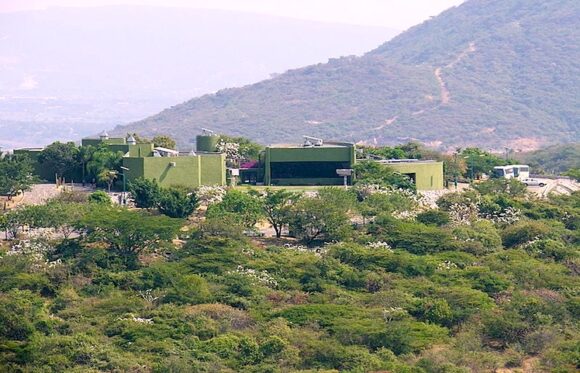The world’s first ecological museum was designed and built in Mexico, at the archaeological site of Xochicalco, in the state of Morelos. The museum, about thirty kilometers south of Cuernavaca, was built as part of Mexico’s celebrations to commemorate the 500th anniversary of the voyage of Christopher Columbus.
The project, which overs 12,676 square meters, was begun in 1993. Basic construction was completed in 1994 and the museum was formally inaugurated in April 1996.
Xochicalco is an interesting archaeological site, best known for its astronomical significance. Some archaeologists have made a case that its most lavishly-decorated pyramid commemorates a major conference of astronomers, held here in the eighth century AD, in order to plan a calendar adjustment.
At Xochicalco, the scenic and imposing ruins visible today reflect only a small part of what was formerly a much more extensive city. Numerous constructions, linked by cobblestone tracks, rise above the platforms; they include palaces, temples, ball courts and more than one “observatory”.
Xochicalco remained prominent until about AD1000, after which it was abandoned. When the Spaniards arrived in the sixteenth century, they learned of the ruins, but had no inkling of their astronomical significance.
Two of the many natural underground caves at Xochicalco show clear evidence of architectural modification, with the perforation of an artificial hole or “chimney” from the cave to the ground above. These vertical shafts enabled very precise celestial observations. For instance, the vertical north side of the five-meter-long chimney down into one cave would have resulted in a precisely vertical beam of sunlight on the days the sun is directly overhead.
Xochicalco was declared a UNESCO World Heritage site in 1999 and receives about 800,000 visitors a year.
The challenge in building the museum is that there is no established settlement near the archaeological site, so there was no local provision of potable water, drainage or electricity.
As a result, the local Mexican architect, Rolando J. Dada y Lemus, designed a building that was almost entirely self-sufficient.
The project, which is fully wheelchair accessible. had three components:
- Access, parking and exterior gardens, covering 4,550 square meters
- Entrance patio and three interior gardens, 1,237 square meters
- Six covered exhibition rooms connected to an entrance hall which has a view of the site, restaurant, administrative and service areas, 1,870 square meters
The museum has parking for 70 cars and 14 buses, and can accommodate 600 people at a time.
How is this museum so sustainable?
- Underlying the museum is a 550,000-liter cistern. For a few months during the winter dry season, water has to be trucked in from a nearby reservoir – this is the only “input” from outside.
- The museum’s interior temperatures remain moderate all year because there is a 20-cm gap between exterior and interior walls. When exterior walls heat up in summer, that heat has little effect on the temperature of the interior walls.
- Shallow outdoor pools around the perimeter cool outside air before it enters the building.
- Skylights, used to illuminate the exhibits, also allow warm air inside the building to escape.
- Photo-voltaic solar panels provide sufficient power for computers, lights, and the cistern pump.
- Rainwater is captured and utilized for much of the year.
- Wastewater is treated and used to water the gardens
The museum cost 6 million pesos to build, but the energy savings alone mean that all that cost has already been “recuperated”. (Similar size museums have electricity bills of around 1 million pesos a year)
Sources:
- Rolando Dada y Lemus, Armando Deffís. Arquitectura: 2001 a 2010: 2007: Edificios ecológicos autofinanciables.
- El Primer Museo Ecológico Del Mundo En México (MexicoAlterno.com, 24 May 2013)
- Aveni, Anthony F. (1980) Skywatchers of Ancient Mexico. University of Texas Press.
- Morante, Rúben B. (1989) “La Gruta del Sol”. México Desconocido, No. 147 (May), pp.17-20.

Sorry, the comment form is closed at this time.